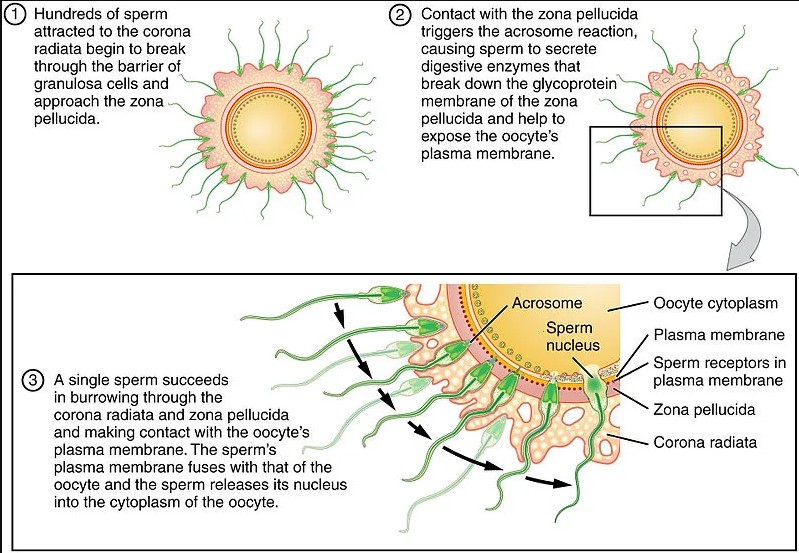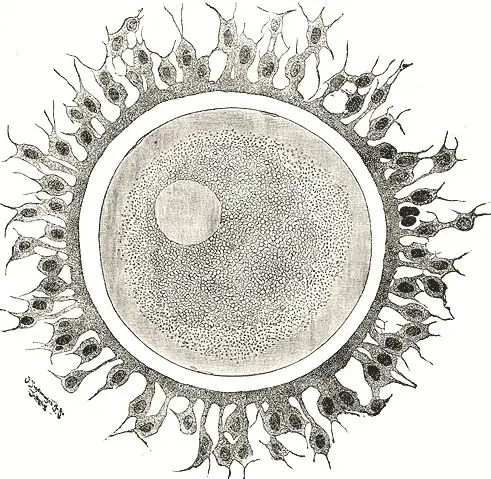The journey from a single cell to a complex organism begins in the most unassuming of places: the mammalian egg cell. Within this microscopic environment, two key structures, the zona pellucida and corona radiata, play pivotal roles. These components are not merely passive barriers but active participants in the dance of fertilization and early embryonic development, ensuring that only the fittest spermatozoa make the cut.
The zona pellucida and corona radiata are integral to the reproductive process, with the former being a glycoprotein layer surrounding the egg cell and the latter a layer of cells providing additional protection and support. The zona pellucida facilitates sperm binding and prevents polyspermy, while the corona radiata aids in nourishing and guiding the sperm towards the egg. This delineation of roles underscores the evolutionary refinement of mammalian fertilization, ensuring species continuity through selective sperm entry.
Elaborating further, the zona pellucida is responsible for the initial sperm cell binding and activation of the acrosome reaction, a critical step in sperm penetration. On the other hand, the corona radiata, composed of follicular cells, forms the outermost layer surrounding the egg, offering it nutrients and hormonal signals essential for its development. These structures’ synergistic functions exemplify nature’s intricacy in orchestrating the beginnings of life.

Zona Pellucida
Basics
The zona pellucida is an essential component of mammalian oocytes, or egg cells. This glycoprotein layer surrounds the plasma membrane of the oocyte. It’s composed of a unique blend of proteins, which are synthesized by both the oocyte itself and the surrounding granulosa cells during the egg’s development within the ovary. Its formation marks a critical step in oocyte maturation, preparing it for potential fertilization.
Function
The functions of the zona pellucida are vital for reproductive success. Key roles include:
- Sperm Binding: It’s the initial site where spermatozoa bind, playing a critical role in the selection of sperm for fertilization.
- Prevention of Polyspermy: Once a sperm penetrates, changes in the zona pellucida prevent additional sperms from entering, ensuring genetic stability.
- Support During Development: It maintains the integrity of the oocyte and early embryo, particularly during passage through the fallopian tube.
Structure
The structure of the zona pellucida is intricate, primarily consisting of glycoproteins known as ZP1, ZP2, ZP3, and ZP4. These proteins interlink to form a dense, yet porous, matrix. During fertilization, the structure undergoes significant changes, becoming hardened to prevent additional sperm from penetrating, a process termed the zona reaction.
Corona Radiata
Basics
The corona radiata consists of several layers of granulosa cells that remain attached to the oocyte post-ovulation. Originating from the ovarian follicle, these cells are crucial for the oocyte’s development and maturation. Their presence around the oocyte is a testament to the oocyte’s journey through the ovarian follicle.
Function
The corona radiata’s functions are diverse and critical for fertilization:
- Nourishment and Protection: It supplies vital nutrients and protective signals to the oocyte, safeguarding its development.
- Facilitating Sperm Penetration: The layers of the corona radiata act as a selective barrier; only the most vigorous sperm can penetrate through to the zona pellucida and the oocyte within.
Structure
The structure of the corona radiata is characterized by its multiple layers of cells. These cells are connected to each other and to the oocyte through gap junctions, facilitating communication and the transfer of small molecules, which is crucial for the oocyte’s metabolic support and maturation.
Comparative Analysis
Structural Differences
Comparatively, the zona pellucida and corona radiata differ significantly in composition and structure. The zona pellucida is a non-cellular, proteinaceous layer, while the corona radiata is composed of multiple layers of living cells. This fundamental difference reflects their distinct origins and functions in the reproductive process.
Functional Differences
Functionally, both structures play roles in fertilization but in different capacities. The zona pellucida is crucial for sperm binding and preventing polyspermy, ensuring that only one sperm fertilizes the oocyte. In contrast, the corona radiata primarily provides nourishment and mechanical protection, and it plays a more passive role in sperm selection.
Evolutionary Significance
The evolutionary significance of these structures lies in their contribution to reproductive success. The zona pellucida and corona radiata have evolved to ensure that sperm undergoes rigorous testing before and during penetration. This selective pressure enhances the chances of successful fertilization and genetic integrity of the offspring, showcasing nature’s meticulous design in optimizing mammalian reproduction.
Fertilization Process
Sperm Interaction
The fertilization process begins when a sperm successfully navigates the corona radiata and then interacts with the zona pellucida. This journey starts with the sperm releasing enzymes to digest through the layers of the corona radiata. Upon reaching the zona pellucida, specific receptors on the sperm’s surface recognize and bind to glycoproteins in the zona pellucida, particularly ZP3 and ZP4. This binding is crucial for the next step, known as the acrosome reaction.
Penetration Mechanisms
The penetration of the corona radiata and zona pellucida involves a series of coordinated steps:
- Acrosome Reaction: Triggered upon binding to the zona pellucida, the sperm’s acrosome (a cap-like structure filled with enzymes) releases its enzymes.
- Enzymatic Digestion: These enzymes break down the glycoprotein matrix of the zona pellucida, creating a pathway for the sperm to reach the oocyte.
- Sperm Entry: Once through the zona pellucida, the sperm makes contact with the oocyte’s membrane, leading to membrane fusion and the eventual entry of the sperm’s nucleus.
Role in Embryonic Development
Post-fertilization, the zona pellucida and corona radiata continue to play roles in embryonic development. The zona pellucida hardens further to prevent additional sperm from penetrating, a crucial step in preventing polyspermy. This hardened layer also protects the developing embryo as it travels down the fallopian tube towards the uterus. Meanwhile, the corona radiata, having fulfilled its role, disperses after fertilization.
Technological and Research Implications
Assisted Reproductive Technologies
Understanding the functions and structures of the zona pellucida and corona radiata has significantly impacted assisted reproductive technologies (ART). Techniques such as in vitro fertilization (IVF) and intracytoplasmic sperm injection (ICSI) are designed with these barriers in mind. For instance, ICSI bypasses the natural penetration mechanisms by directly injecting a sperm into the oocyte, overcoming challenges related to zona pellucida or corona radiata penetration. Similarly, advancements in embryo culture methods have taken cues from the protective environment provided by these structures.
Future Research Directions
Current research on the zona pellucida and corona radiata is paving the way for novel fertility treatments and a deeper understanding of human genetics. Key areas of focus include:
- Zona Pellucida and Corona Radiata Biomimetics: Developing materials and surfaces that mimic these structures could improve ART techniques, making them more efficient and less invasive.
- Genetic Studies: Understanding the genes involved in the formation and function of these structures could help identify causes of infertility related to zona pellucida and corona radiata anomalies.
- Drug Development: Targeting the specific interactions between sperm and the zona pellucida or corona radiata may lead to new contraceptives or treatments for infertility.
Frequently Asked Questions
What is the Zona Pellucida?
The zona pellucida is a thick, extracellular matrix that encases the mammalian oocyte. Composed mainly of glycoproteins, it plays a crucial role in the fertilization process by facilitating sperm binding, initiating the acrosome reaction, and preventing multiple sperms from fertilizing the same egg, thus ensuring genetic integrity.
How Does the Corona Radiata Support Fertilization?
The corona radiata, comprising several layers of granulosa cells that remain attached to the oocyte after ovulation, supports fertilization by providing essential nutrients and signaling molecules to the oocyte. It also serves as a selective barrier, allowing only the most capable sperm to penetrate its defenses and reach the oocyte.
Why Are the Zona Pellucida and Corona Radiata Important?
The zona pellucida and corona radiata are vital for successful fertilization and early embryonic development. They ensure that only properly functioning sperm can fertilize the egg, prevent polyspermy, and support the oocyte until implantation. Understanding their roles and mechanisms can also aid in the development of fertility treatments and contraceptives.
Conclusion
The interplay between the zona pellucida and corona radiata is a marvel of biological engineering, fine-tuned by millions of years of evolution. Their roles in the reproductive process exemplify nature’s precision in safeguarding the continuity of life through meticulous selection and nurturing of the next generation. As we delve deeper into their functions and interactions, we uncover more about the intricacies of life’s beginnings, offering insights that could revolutionize reproductive medicine and fertility treatments.
The understanding of these structures not only enriches our knowledge of biology but also opens doors to novel medical interventions. As research progresses, the potential to address infertility, develop new contraceptives, and improve assisted reproductive technologies grows, showcasing the invaluable contribution of studying the zona pellucida and corona radiata to both science and humanity.

